Media Coverage of Mass Shootings: Is it Part of the Problem?
When it comes to coverage of mass shootings in the United States, the media can be fickle. School shootings like the one in Florida last month, for example, are more likely to get attention — and tend to garner more sustained attention — than shootings that occur in other places like businesses, malls, and coffee shops, even though the latter are more common. A high death toll is an even better predictor of coverage, of course — but so too are the use of more than one gun, attacks linked to ideological extremism, and those perpetrated by people of Middle Eastern descent. This holds true even though simple handguns are more frequently the weapon of choice, most shooters are white, and ideological motivations are uncommon.

The news media is fickle in how — and for how long — it covers mass shootings. And research suggests that the coverage habits of the press aren’t helping matters.
Visual: Undark
Such are some of the findings in a new study that examined mass shootings in the U.S. over the last 50 years, and the researchers reach a sobering conclusion: “This work finds the media is distorting the reality of mass public shootings,” write the study’s co-authors.
This is particularly worrying because people get most of their information about crime from the news media. Biased or sensational coverage of mass shootings could provoke panicked and misplaced public responses to these incidents, including unnecessary, excessive, or ineffective policies and legislation, says co-author Jason Silva, a doctoral student at John Jay College of Criminal Justice. The distortions can also lead to legislative responses to mass shootings that fail to address the most common characteristics of rampage attacks — specifically, that they are committed predominantly by middle-aged white men using handguns in business settings, Silva says.
Instead, prevention efforts could focus on training people, especially in workplaces, to spot early warning signs that someone might resort to gun violence, wrote Silva and his co-author, criminologist Joel Capellan, at Rowan University, in their study published last month in the International Journal of Comparative and Applied Criminal Justice.
To assess the mismatch between actual events and news coverage, the researchers first used eight search engines to identify a total of 314 mass public shootings — that is, those in which perpetrators killed or tried to kill four or more victims, using a firearm — between 1966 and 2016. The idea was to capture events with shooters who intended to kill as many people as possible, whether they succeeded or not. And unlike many past studies on this topic, incidents motivated by terrorism or extremist violence were included. Then, Proquest’s New York Times Historical Database was used to identify which events were directly covered or mentioned, and the number of articles and words about them or mentioning them, in the print edition of the newspaper during the same period.
The researchers focused on The New York Times because they considered it a reliable indicator of the newsworthiness and importance of current events in the nation’s media. A total of 72 percent of all mass public shootings in the U.S. during the 50-year period studied were covered by The Times, the researchers found.
The recent shooting at Marjory Stoneman Douglas High School in Parkland, Florida has received an enormous amount of media coverage so far because it took place in a school and involved a younger shooter, Silva says. Shootings by younger perpetrators are more likely to receive coverage than those committed by older perpetrators, the new research shows. And the Parkland attack took many victims, although not as many as the 2016 Orlando nightclub shooting (49 killed, 58 wounded), or last year’s massacre in Las Vegas (58 killed, 851 injured).
One hopeful difference in the most recent attack is that media covering the Parkland shooting have given more prominence to the victims and survivors than is typical of past incidents, Silva says. “This could suggest a new direction in the coverage focused more on victims and less on offenders,” he adds.
That’s something that movements like “Don’t Name Them” and “No Notoriety” have begun lobbying for, and they are not alone. In an essay published last year, two criminologists — Adam Lankford of the University of Alabama, and Eric Madfis of the University of Washington, Tacoma — suggested that the media needs to do some real soul-searching in how it covers shootings in America.
“Prior research has shown that many mass shooters have explicitly admitted they want fame and have directly reached out to media organizations to get it,” the researchers noted. “These fame-seeking offenders are particularly dangerous because they kill and wound significantly more victims than other active shooters, they often compete for attention by attempting to maximize victim fatalities, and they can inspire contagion and copycat effects.
“However, if the media changes how they cover mass shooters,” they added, “they may be able to deny many offenders the attention they seek and deter some future perpetrators from attacking.”











Comments are automatically closed one year after article publication. Archived comments are below.
I forecast many more mass shootings across the US. In fact I also predict by arithmetic principals there will be simultaneous mass shootings happening in a same day peroid. I feel we’ve only just begun. I see a sharp increase in suicides as well. Toddlers both as a victim and perp.
There have been millions of weapons sold in the past 10 years added to the existing stock. These weapons, originally purchased to fight a tyrannical government led by Obama, Eric Holder, and other “leftists”. Weapons to “fight the ZOG”. This delusional threat is no longer forefront with the Alt Right victory of 2016. These weapons haven’t gone away tho. Guns can remain operational for decades. The stockpiled ammunition across America will remain functional too. Throughout the next 30 years or so these guns will be sold traded or stolen and whose hands they will end up in is anyone guess. Some guns will be available by household members and used for other nefarious deeds apart from their original intent. Those weapons bought only as a symbol of patriotism will infact be used to murder those in the immediate circle whom they meant to protect. The killing is just begun.
Without losing sight of the reality of tragedy and personal loss, it is remarkable how distortion of reality seems to be hard wired into human nature, whether from news media distortion to social media amplification of the worse. Is it simply inevitable we tend to be like Trump, who says “I know those are the facts, but I don’t believe them!”? As with the 80s and 90s, perception continues to trump reality. And while statistics like these are incomplete, they are as close to the truth as we can get, and truer than the monsters we create in our own minds. Unless we truly want perception to replace reality.
Yes a good read, and taking it further there’d be no chance that at least some sections of the media might be even more perniciously complicit in that they might be seeking to encourage such events for their own political and/or economic reasons would there?
The NYT, a reliable indicator? Sorry.
Thanks Robin,
This has been a pleasure to read. Thank you for not only understanding the truth about the aftermath of school shootings but expressing those truths in a manner that most journalist today will not..